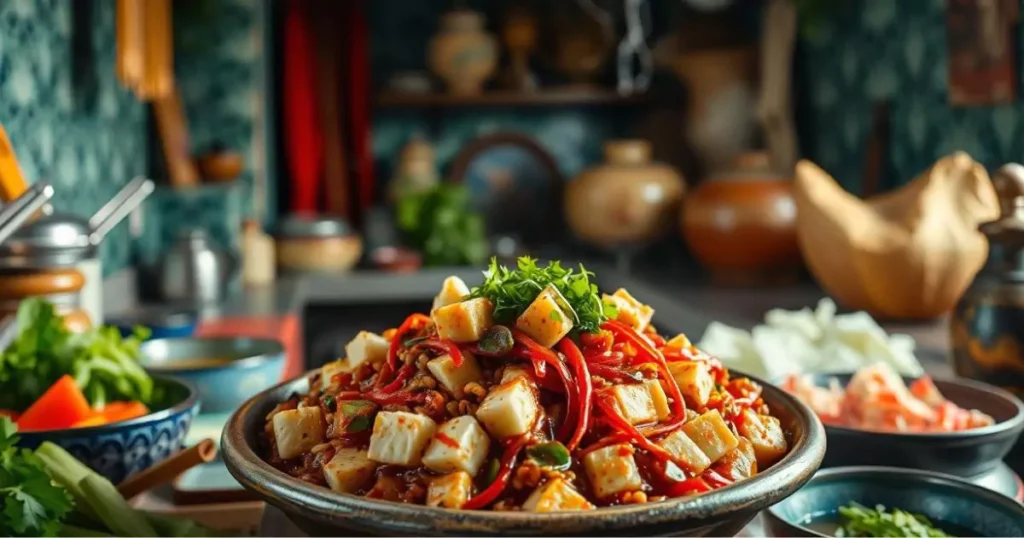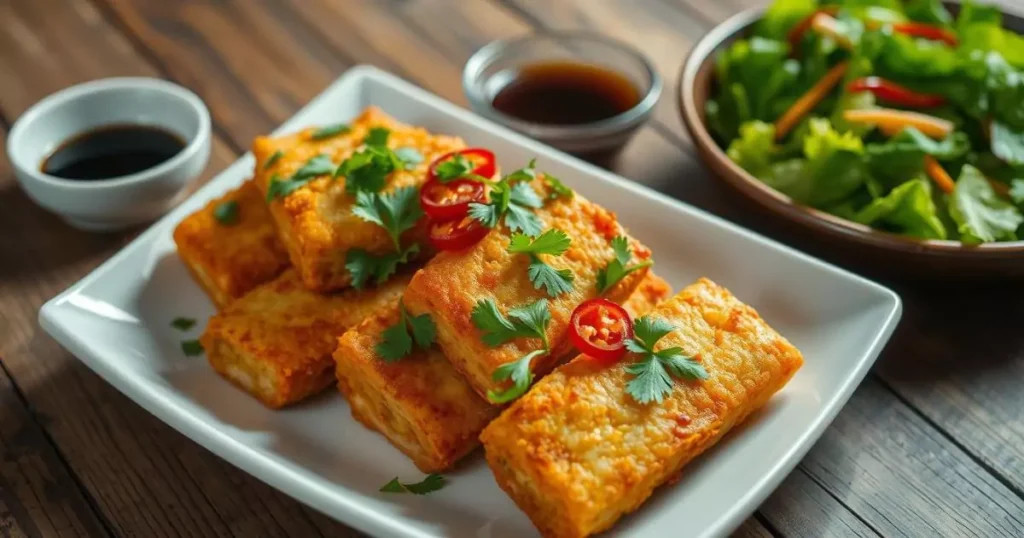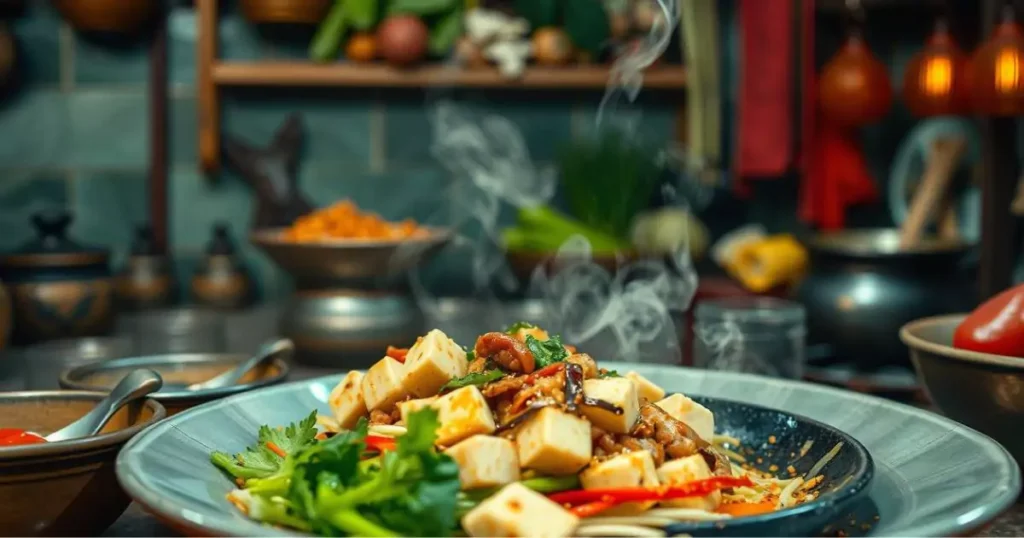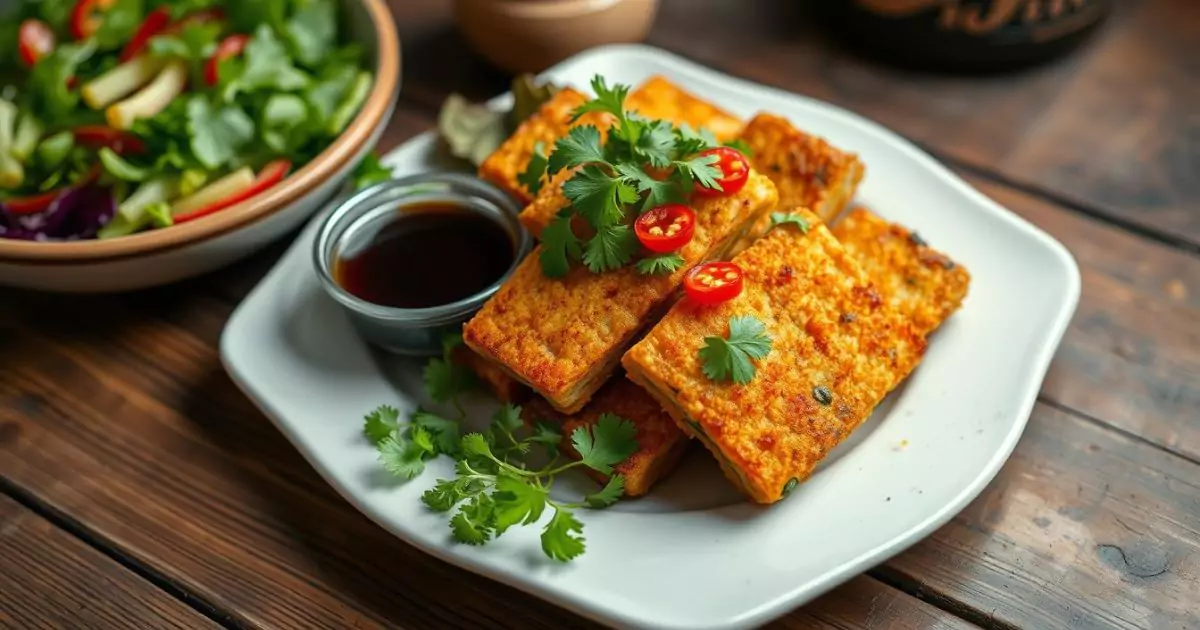tauhu recipe – Best recipes
Table of Contents
I love cooking at home and exploring the rich flavors of Southeast Asian cuisine. Tauhu, or tofu, is a favorite of mine. It can be turned into many delicious dishes. When I eat a crispy, flavorful tauhu dish, I feel like I’m in Kuala Lumpur or Bangkok.
In this guide, I’ll show you how to make the perfect tauhu recipe. We’ll cover its cultural importance, key techniques, and tasty variations. This journey will spark your love for cooking and make you want more.
Understanding Tauhu: Origins and Cultural Significance
Tauhu, also known as tofu, is a beloved ingredient in Southeast Asian cuisine. It originated in China over two centuries ago. Since then, it has spread across East Asia and become popular worldwide, especially in vegetarian and vegan diets.
Traditional Uses in Southeast Asian Cuisine
Tauhu has been a staple in Southeast Asia for centuries. In Indonesia, it’s a key part of many authentic Asian flavors. In the Philippines, it’s enjoyed as tahô or tokwa for breakfast. Its cultural importance is clear in its widespread use and the many regional variations in southeast asian cuisine.
Cultural Importance of Tauhu Dishes
Tauhu dishes are dear to many Southeast Asian cultures. In Japan, the soft variety is used in Hiyayakko, a refreshing summer appetizer. Deep-fried tauhu pouches are key in Inarizushi and Kitsune udon. The Japanese version of mapo tofu, Mabodofu, has been a favorite since the 1970s.
Regional Variations and Names
Tauhu, or tofu, has many names and preparations across Southeast Asia. In Korea, it’s called dubu and is a common side dish. In Indonesia, it’s known as tauhu. These regional variations show the cultural importance of this versatile ingredient in indonesian delicacies and more.
“Tofu has been consumed in China for over 2,000 years and has become a traditional component of East Asian and Southeast Asian cuisines.”
Essential Ingredients for the Perfect Tauhu Recipe
To make a delicious tauhu dish, start with the right ingredients. Extra-firm tofu is key for crispy edges and a soft inside. Soy sauce or Bragg Liquid Aminos add flavor, while sesame oil brings a nutty taste.
In a Korean-style tauhu, gochugaru, sugar, and sesame seeds are important. The tofu you choose is crucial. Garlic and green onions add aromatic flavors that make the dish better.
The right ingredients make a great tauhu dish. By mixing these flavors well, you can make a meal that’s both tasty and healthy. This way, you can impress your guests with a meal that’s full of flavor.
“The secret to the perfect tauhu dish lies in the quality of the ingredients. Seek out the freshest, high-quality tofu and pair it with complementary flavors to create a truly unforgettable culinary experience.”
Preparing Your Tofu: Fundamental Techniques
Getting your tofu right is key for a great taste and texture in your tauhu recipe. From draining excess water to cutting and shaping, these steps are crucial. They will help you cook like a pro.

Proper Draining Methods
The first thing to do is get rid of any extra water from the tofu. You can pat it dry with a clean cloth or paper towels. Or, place it between two plates or cutting boards for 15-30 minutes. This lets the water drain out naturally.
Cutting and Shaping Techniques
After draining, cut the tofu into the shape you want. You can make 1-inch cubes or ¼-inch thick slices. Cutting it evenly helps it cook better and look good.
Pre-cooking Preparations
Pre-cooking the tofu can make it taste and feel better. Lightly salt the tofu to remove more moisture. This helps it get crispy on the outside when cooked.
| Tofu Texture | Ideal Preparation |
|---|---|
| Silken Tofu | Gently pat dry and slice or cube |
| Firm or Extra-Firm Tofu | Drain, press, and cut into desired shapes |
Learning these basic tofu preparation steps will help you make tasty tauhu dishes. These dishes highlight the great taste and health benefits of vegetarian protein.
Classic Pan-Fried Tauhu Recipe
Turning tauhu (or tofu) into a crispy, golden delight is the goal of a classic pan-fried tauhu recipe. It’s great for vegetarians and vegans. It also offers a tasty plant-based protein option for those cutting down on meat.
To get the perfect pan-fried tauhu, you need a few key ingredients and some cooking skills. Choose firm or extra-firm tauhu. It’s sturdy and won’t fall apart when cooked at high heat.
- Start by draining the tauhu well and patting it dry with paper towels. This helps it crisp up nicely when fried.
- Then, cut the tauhu into small cubes or slices. Smaller pieces cook faster and get that golden-brown color quicker.
- Heat a lot of oil, like grapeseed, sunflower, or avocado oil, in a skillet or wok over medium-high heat. When the oil is hot, add the tauhu pieces carefully. Don’t overcrowd the pan.
- Fry the tauhu for 5-7 minutes on each side. It should turn golden-brown and crispy. Be patient and don’t move it too much to get a good sear.
To make your pan-fried tauhu even tastier, try a simple dipping sauce. Mix soy sauce, Korean chili flakes, garlic, green onions, sesame oil, and toasted sesame seeds. Drizzle it over the tauhu or serve it on the side for dipping.
| Nutritional Information (per serving) | Value |
|---|---|
| Calories | 117 kcal |
| Carbohydrates | 3 g |
| Protein | 2 g |
| Fat | 11 g |
| Sodium | 772 mg |
| Fiber | 1 g |
Learning to pan-fry tauhu opens up a world of possibilities. You can serve it as a main dish, a side, or add it to your favorite tahu recipe. This classic method is sure to impress and satisfy your taste buds.
Creating the Perfect Seasoning Sauce
The secret to a great tauhu recipe is the seasoning sauce. This sauce is what makes the tofu come alive. It fills it with the deep, aromatic tastes of Southeast Asian cuisine and authentic Asian flavors. Let’s look at what makes the seasoning sauce for your tauhu dish perfect.
Base Sauce Components
The base of the seasoning sauce includes soy sauce, sugar, and water. Soy sauce gives a savory umami taste. Sugar adds sweetness, and water balances the flavors.
Spice Combinations
- Gochugaru, a Korean chili powder, adds a subtle heat and vibrant red color.
- Black pepper gives a warm, peppery kick that complements the other tastes.
- Regional spices like cumin, coriander, or turmeric can be added to match your Southeast Asian dish’s flavors.
Aromatics Selection
The aromatic ingredients elevate the sauce. Minced garlic, onions, and green onions add depth. A drizzle of sesame oil brings a nutty, toasted aroma. Cornstarch can be used to thicken the sauce.
By mixing these ingredients well, you’ll make a seasoning sauce that enhances your tauhu dish. It will take your taste buds on a journey to the lively food scenes of Southeast Asia.

Advanced Cooking Techniques for Crispy Tauhu
To get crispy tauhu, you need some advanced techniques. The secret is in how you prepare and cook it. Let’s dive into the methods that make your tauhu dishes crispy and delicious.
First, make sure to drain and pat the tauhu dry. Too much moisture stops it from getting crispy. Use a towel or paper towels to soak up the liquid from the tauhu cubes or slices.
Choosing the right pan is also key. Use a non-stick skillet or pan to prevent sticking and ensure even browning. Just a little oil is needed to lightly coat the pan.
- Chilling the tauhu in the freezer for 4-6 hours or overnight makes it firmer and crisper.
- Coating the tauhu in cornstarch before frying creates a crispy crust.
- Cook the tauhu over medium-high heat to get a golden-brown crust. Don’t overcrowd the pan and avoid moving the pieces too much.
With these techniques, you can make your tauhu recipe even better. Enjoy the crunch of perfectly crispy vegetarian protein. Try different seasonings and sauces to create your own tofu recipes that will wow everyone.
“Crispy tauhu is the ultimate vegetarian delight – it’s a blank canvas for endless flavor possibilities.”
| Nutrient | Amount per Serving |
|---|---|
| Calories | 113 |
| Carbohydrates | 4g |
| Protein | 8g |
| Fat | 7g |
Vegetarian Protein Options and Variations
Tauhu (tofu) is a great way to add plant-based protein to your diet. It’s versatile and nutritious. There are many vegetarian protein options and variations to make your tauhu recipes better.
Plant-Based Adaptations
While traditional tauhu is popular, trying different types of tofu can be exciting. Firm or extra-firm tofu works well for pan-frying and baking, giving a heartier texture. Silken tofu, on the other hand, is perfect for creamy sauces and dips, adding a luxurious feel to your meals.
Tempeh, a fermented soybean cake, is also a great source of vegetarian protein. Its nutty, slightly chewy texture makes it a great meat substitute in dishes like tauhu bacem or tauhu tahu telur. Adding tempeh to your tauhu recipes can make them more complex and interesting.
Texture Enhancements
Getting the right texture is important for delicious tauhu dishes. Freezing and thawing tofu before cooking can make it chewier. This helps remove excess moisture, making it more satisfying to eat.
Using extra-firm tofu can also improve texture. Its higher density helps it keep its shape during cooking, making it perfect for stir-fries, skewers, or tauhu bacem. Trying different tofu textures can open up new possibilities for your vegetarian meals.
| Vegetarian Protein Source | Texture and Mouthfeel | Ideal Cooking Methods |
|---|---|---|
| Firm or Extra-Firm Tofu | Heartier, chewier texture | Pan-frying, baking, stir-frying |
| Silken Tofu | Creamy, luxurious mouthfeel | Blending into sauces and dips |
| Tempeh | Nutty, slightly chewy texture | Braising, sautéing, stir-frying |
Exploring these vegetarian protein options and texture enhancements can lead to a world of tasty, meatless dishes. These dishes will please your taste buds and nourish your body.
Pairing and Serving Suggestions
Enjoying tauhu dishes from Southeast Asian cuisine is a treat. These Indonesian delicacies can be used in many dishes, making every meal special. They add flavor and satisfaction to your food.
For a cozy meal, try tauhu with fluffy rice. The rice’s mild taste lets the tauhu‘s rich flavors shine. Add a crisp salad with fresh greens, cherry tomatoes, and herbs like mint or basil for a refreshing touch.
In Korean cuisine, tauhu is a favorite banchan. It’s a side dish that goes well with many main courses. It can make a simple meal into a fancy dinner when paired with other Korean dishes.
Looking for a hearty meal? Use tauhu in plant-based dishes. Serve it over quinoa or with sautéed veggies for a filling dinner. The ways to enjoy tauhu are endless, thanks to creative pairings and serving ideas.
“The versatility of tauhu is truly remarkable, allowing it to shine in a wide array of culinary creations, from simple weeknight meals to elaborate feasts.”

Storage Tips and Leftover Solutions
Storing your tauhu right is key to keeping its taste and texture. Cooked tauhu can stay fresh in the fridge for 4-5 days in an airtight container. To make it crispy again, try pan-frying or baking it in the oven instead of microwaving. Korean pan-fried tofu is great even when it’s cold.
Leftover tauhu can be used in many ways to spice up your meals. Add it to stir-fries, salads, or sandwiches for a protein-rich meal. With a little creativity, you can turn leftover tauhu into a new, tasty dish.
Proper Storage Methods
Unopened tauhu lasts only 3 to 5 days. But opened tauhu, kept in the fridge with daily water changes, can last up to a week. Cooked tauhu stays fresh for 5 days in the fridge if stored in an airtight container. For longer storage, freeze it for up to 5 months in a sealed container or freezer bag.
Reheating Guidelines
To enjoy your leftover tauhu, pan-frying or oven-baking is best to get that crispy texture. Microwaving can make it softer. Korean pan-fried tofu is great served cold, making it easy and flexible.
FAQ
What is tauhu, and how is it used in Southeast Asian cuisine?
Tauhu, also known as tofu, is a key ingredient in Southeast Asia. It’s used in many dishes across the region. Each country has its own way of using it in their food.
What is the cultural significance of tauhu in Southeast Asian cuisines?
Tauhu is very important in Southeast Asian food. It’s used in many traditional dishes. In Korea, it’s called dubu and is a big part of their meals.
What are the key ingredients for a classic tauhu recipe?
A classic tauhu recipe needs extra-firm tofu, soy sauce, and sesame oil. You’ll also need garlic, green onions, and spices. For a Korean twist, gochugaru, sugar, and sesame seeds are added.
How should tauhu be prepared for optimal texture and flavor?
To prepare tauhu right, drain and pat it dry. Cut it into shapes you like. Salting it before cooking helps with flavor and moisture.
What is the process for making a classic pan-fried tauhu dish?
To make pan-fried tauhu, cook the tofu in hot oil until it’s golden and crispy. This takes about 5 minutes per side. Then, dress it with a tasty sauce and garnish with sesame seeds and green onions.
What are the key components of a delicious tauhu seasoning sauce?
A good tauhu sauce has soy sauce, sugar, and water. You can add gochugaru, black pepper, or other spices. Garlic, onion, and green onions add flavor. Sesame oil and cornstarch are used for taste and thickening.
What are some advanced techniques for achieving crispy tauhu?
For crispy tauhu, drain and pat the tofu dry. Use a non-stick skillet and the right oil. Coat it in cornstarch before frying for extra crispiness. Cook over medium-high heat until it’s golden.
How can tauhu be adapted for vegetarian or plant-based diets?
For vegetarian diets, use different tofu types or tempeh. Freeze and thaw tofu for a meatier texture. This makes tauhu dishes great for plant-based meals.
What are some recommended ways to serve and pair tauhu dishes?
Serve tauhu with rice and side dishes. In Korea, it’s a side dish (banchan) with meals. Pair it with a fresh salad, cherry tomatoes, and herbs like mint or basil.
How can leftover tauhu be stored and reheated?
Store cooked tauhu in an airtight container for up to 4-5 days. Reheat by pan-frying or oven-baking. Korean pan-fried tofu is great cold. Use leftover tauhu in stir-fries, salads, or sandwiches.

